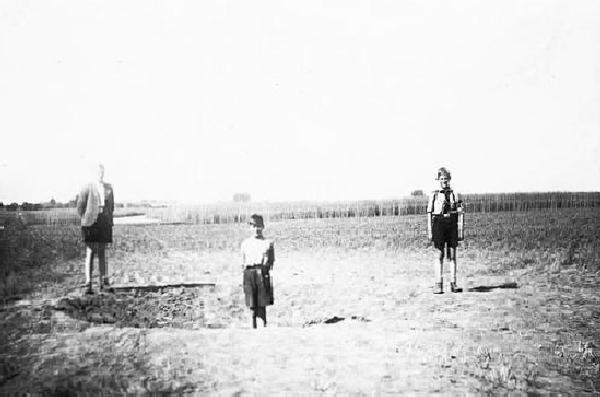
World War II Air Campaign: British Raid near Oerie (June 8, 1940)

Figure 1.--Military experts at the beginning of World War II differed as to the potential impact of strategic bombing. Some felt that air forces could win the war without the need of large ground armies. Others saw the air force as most effectively used as a ground support force. Such tactical operations could achieve considerable accuracy. The Germans had a limited industrial capability and thus the Luftwaffe was primarily a tactical force. (The principal reason the Luftwaffe failed in the Nattle of Britain.) The British built both a tactical and strategic force. The initial operations of Bomber Command were largely ineffective. German anti-aircraft defenses and fighters forced Bomber Command to attack at night. As a result most bombs missed the intended targets, often the bombers could not even find the ntended city, let along hit a specific target in the city. British bombs commonly fell miles from the target. Here we see a bomb crater obviously not close to any target. It is being examened by German boys in 1940. One of the boys is wearing his Hitler Youth uniform. Click on the photograph to see the back.
|
Military experts at the beginning of World War II differed as to the potential impact of strategic bombing. Some felt that air forces could win the war without the need of large ground armies. Others saw the air force as most effectively used as a ground support force. Such tactical operations could achieve considerable accuracy. The Germans had a limited industrial capability and thus the Luftwaffe was primarily a tactical force. (The principal reason the Luftwaffe failed in the Nattle of Britain.) The British built both a tacticl and stategic force. The initial operations of Bomber Command were largely ineffective. German anti-aircraft defenses and fighters forced Bomber Command to attack at night. As a result most bombs missed the intended targets, often the bombers could not even find the ntended city, let along hit a specific target in the city. British bombs commonly fell miles from the target. Here we see a bomb crater obviously not close to any target. It is being examened by German boys in 1940. One of the boys is wearing his Hitler Youth uniform.
Military Thinking
Military experts at the beginning of World War II differed as to the potential impact of strategic bombing. Some felt that air forces could win the war without the need of large ground armies. Others saw the air force as most effectively used as a ground support force. Such tactical operations could achieve considerable accuracy.
The Luftwaffe
The Germans had a limited industrial capability. They could not build both a significant tactical and strategic air force. The Luftwaffe was a very new force. Luftwaffe commanders were drawn from the Wehrmact. Thus from the beginning there was a focus on tactical ground support operations. Thus the Luftwaffe was primarily a tactical force. The principal reason the Luftwaffe failed in the upcoming Battle of Britain. By June 8 the Luftwaffe concept of ground support as part of Blitzkrieg. The Germans had reached the Channel in France and were only a few days from Paris.
The Allies
The British built both a tactical and strategic force, although in 1940 RAF Bomber Command was still small and equipped with air craft that had limited range and bomb payloads. America was not yet in the War, but had already began to build a large srategic bomber force around the B-17 Flying Fortress.
Innacuracy
The initial operations of Bomber Command were largely ineffective. German anti-aircraft defenses and fighters forced Bomber Command to attack at night. As a result most bombs missed the intended targets, often the bombers could not even find the ntended city, let along hit a specific target in the city. British bombs commonly fell miles from the target. The American Army Air Force believed that they solved this problem with the top secreat Norton bomb site. When America finally entered the air war, they found they had not accounted for the impact of German defenses and the often overcast weather of Northern Europe.
Photograph
Here we see a bomb crater obviously not close to any target. It is being examened by German boys in 1940. One of the boys is wearing his Hitler Youth uniform. The German text reads "Brisanz bombe, am 8. Juni 1940, bei Oerie)". That means "Brisance bomb, on June 8, 1940, near Oerie." Oerie is close to Hanover. I am not sure what a Brisance bomb is.
We do know that brisance is a measure of the speed with which an explosive develops its maximum pressure. Why the term is used here I am not quite sure. The thought occurred to us that this could be a German bomb test. I don't believe, however, that on a test range that the Germans would have allowed children, even after the test.
The boys in the photograph certainly are German because one wears a Hitler Youth uniform. The photograph illustrates several important points. Notice that this bomb fell in a field not near any military target, a good indication of how poor British targeting was at this stage of the War. Also notice the relatively small size of the crater and the fact that it is one single crater--a good illustration of the very limited bomb capacity of RAF bombers in 1940.
HBC

Navigate the Boys' Historical Clothing Web Site:
[Return to Initial Allied bombing campaign]
[Return to Main World War II aerial campaign page]
[Return to Main World War II page]
[Introduction]
[Activities]
[Biographies]
[Chronology]
[Clothing styles]
[Countries]
[Bibliographies]
[Contributions]
[FAQs]
[Glossaries]
[Satellite sites]
[Tools]
[Boys' Clothing Home]
Created: 6:17 PM 5/2/2006
Last updated: 6:17 PM 5/2/2006



